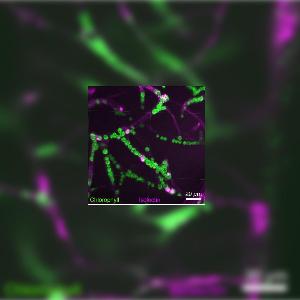Neurobiology: A “green lung” for the brain
13 Oct 2021
LMU neurobiologists have shown that photosynthetic micro-organisms can be used as a source of oxygen for nerve cells.
13 Oct 2021
LMU neurobiologists have shown that photosynthetic micro-organisms can be used as a source of oxygen for nerve cells.

Distribution of the microorganisms through blood vessels. Source: Özugur et al., iScience 2021
Nerve cells in the brain must process large amounts of signals every second. Most of the energy required to perform these tasks is generated by aerobic metabolism – which explains why the brain depends on the constant supply of adequate amounts of oxygen. Animals must obtain their oxygen from the environment. On the other hand, photosynthetic organisms, such as plants, are capable of producing it themselves, using sunlight as an energy source. A research group led by LMU neurobiologist Hans Straka and LMU molecular plant scientist Jörg Nickelsen has now shown that photosynthetic micro-organisms can be used to directly provide the brain with oxygen. Their findings appear in the journal iScience.
The researchers introduced photosynthetic micro-organisms – unicellular green algae and cyanobacteria – into the blood vessels of tadpoles of the clawed frog Xenopus laevis, an established experimental model. After isolation, when the brains were exposed to light, measurements of oxygen levels in the ventricles of the tadpole brain revealed that substantial amounts of oxygen were indeed being produced. “Conversely, in an oxygen-poor medium, nerve-cell activity came to a complete halt in darkness,” says Straka. “When the light was turned on again, the micro-organisms generated oxygen, and the neurons restarted firing. So, the oxygen generated by photosynthesis is indeed utilized to rescue neuronal activity.”
According to the authors, these proof-of-principle experiments demonstrate that unicellular photosynthetic micro-organisms could serve as a novel means of boosting the supply of oxygen to tissues in a controlled fashion. They could, for example, be used to enhance oxygen levels in cell cultures, in explanted organs or in brain slices. “Furthermore, photosynthetic organisms produce not only oxygen, but also sugars, for example. So it’s conceivable that their metabolic pathways could be exploited to synthesize nutrients as well,” says Straka. Since the intensity, duration and spectrum of light can be controlled with great precision, the method could also provide new approaches to the investigation of the role of oxygen in metabolic processes.
Suzan Özugur, Myra N. Chávez, Rosario Sanchez-Gonzalez, Lars Kunz, Jörg Nickelsen and Hans Straka: Green oxygen power plants in the brain rescue neuronal activity. iScience 2021